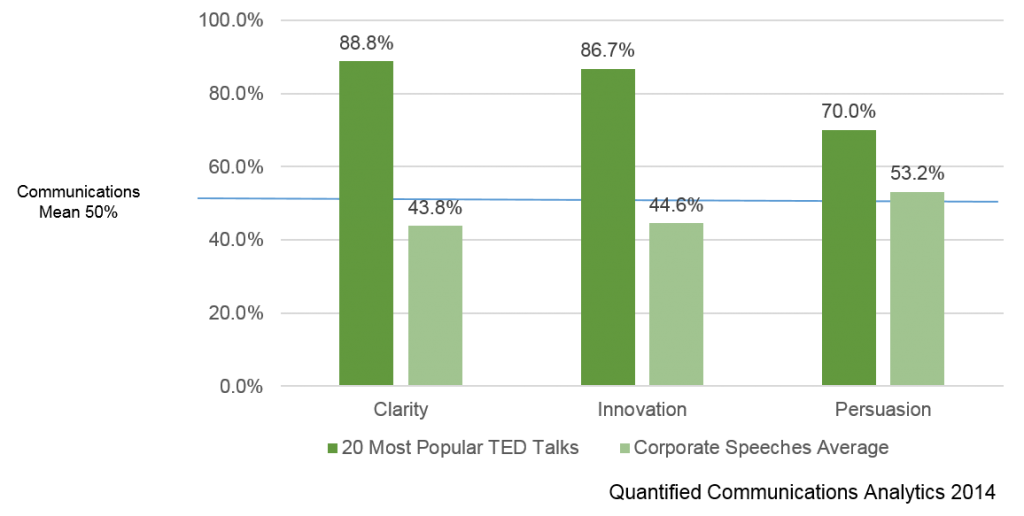What makes a TED speaker great ?

TED, a nonprofit organization known for its presentations of short, provocative talks on cutting-edge ideas, has compiled the 20 most popular TED Talks, which can be viewed on the organization’s website. Although TED began as a conference on Technology, Entertainment and Design, TED talks now cover a variety of topics and issues, and many of its speakers have become well known as a result of their talks.
This list got us asking, what separates the language of the most popular TED talks (such as How Schools Kill Creativity from Sir Ken Robinson, or Your Body Language Shapes Who You Are from Amy Cuddy) from the language of average communicators? What can we learn from these best-in-class speakers?
To find out, we leveraged our natural-language processing and linguistic-mapping tools to analyze the transcripts from the top TED talks. We then compared them to our communications database of more than 100,000 communicators. By analyzing the linguistic techniques of these speakers, we were able to pinpoint what factors separate the language of an outstanding TED talk from the language of an average communicator.
In comparing the TED talks to our communications database, we found the language of the most popular TED Talks to be:
- Clear – On average, the top 20 TED speakers score 39% higher on message clarity than our database average.
- TED speakers are presented with the challenge of telling their story in 18 minutes or less. In explaining the rationale for the 18 minute limit, TED curator Chris Anderson said:“By forcing speakers who are used to going on for 45 minutes to bring it down to 18, you get them to really think about what they want to say. What is the key point they want to communicate? It has a clarifying effect. It brings discipline.”
- With the top 20 TED speakers communicating, on average, at a 7th grade level, the clarifying effect seems to be working.
- Innovative – On average, the top 20 TED speakers use 37% more innovative language than our database average.
- Innovative language describes the steps taken and achievements accomplished in order to bring a new idea to life.
- It’s not surprising that we found such a high proportion of innovative language from the top 20 speakers. Many of these people were invited to speak on the TED stage primarily because of their innovative accomplishments and insights. When describing how she finds speakers for the TED stage, Kelly Stoetzel, director of content at TED says:“We really look for people who have a new lens on an existing idea and can communicate it clearly and with passion.”
- Persuasive – The language used by the top 20 speakers was 20% more persuasive than the average speaker in our database.
- How can you persuade an audience in 18 minutes or less? The top 20 speakers are persuasive because they make their message relevant to their audience. Studies have shown that simply addressing the audience directly as you versus one can increase their attention. Others have shown that personally relevant information has a greater impact on the audience’s judgment than information that lacks personal relevance.
- We found that the top 20 TED speakers use the second person pronoun (you) twice as often as our database average for spoken communication.
What can we learn from these best-in-class speakers? The goal of TED is to spread great ideas and spark conversation. In order to accomplish this, the data suggests that you should speak directly to your audience about innovative ideas, incorporating information that they will find personally relevant.
